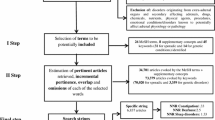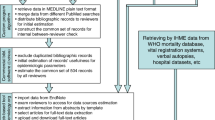Abstract
Biomedical literature has enormously grown in the last decades and become broadly available through online databases. Ad-hoc search methods, created on the basis of research field and goals, are required to enhance the quality of searching. Aim of this study was to formulate efficient, evidence-based PubMed search strategies to retrieve articles assessing etiologic associations between a condition of interest and hypothalamic-pituitary disorders (HPD). Based on expert knowledge, 17 MeSH (Medical Subjects Headings) and 79 free terms related to HPD were identified to search PubMed. Using random samples of abstracts retrieved by each term, we estimated the proportion of articles containing pertinent information and formulated two strings (one more specific, one more sensitive) for the detection of articles focusing on the etiology of HPD, that were then applied to retrieve articles identifying possible etiologic associations between HPD and three diseases (malaria, LHON and celiac disease) considered not associated to HPD, and define the number of abstracts needed to read (NNR) to find one potentially pertinent article. We propose two strings: one sensitive string derived from the combination of articles providing the largest literature coverage in the field and one specific including combined terms retrieving ≥40 % of potentially pertinent articles. NNR were 2.1 and 1.6 for malaria, 3.36 and 2.29 for celiac disease, 2.8 and 2.2 for LHON, respectively. For the first time, two reliable, readily applicable strings are proposed for the retrieval of medical literature assessing putative etiologic associations between HPD and other medical conditions of interest.

Similar content being viewed by others
References
Bachmann LM, Coray R, Estermann P, Ter Riet G (2002) Identifying diagnostic studies in MEDLINE: reducing the number needed to read. J Am Med Inform Assoc 9:653–658
Norgaard O, Lazarus JV (2010) Searching PubMed during a pandemic. PLoS ONE 7:e10039
National Library of Medicine (2010) Factsheet PubMed®: MEDLINE® Retrieval on the World Wide Web. Bethesda (MD): National Library of Medicine (US). Available from: http://www.nlm.nih.gov/pubs/factsheets/pubmed.html. Accessed 29 September 2012
Rollin L, Darmoni S, Caillard JF, Gehanno JF (2010) Searching for high-quality articles about interventions studies in occupational health—what is really missed when using only the Medline database? Scand J Work Environ Health 36:484–487
National Library of Medicine (2010) Factsheet PubMed®: medical subject headings (MeSH). Bethesda (MD): National Library of Medicine (US). Available from: http://www.nlm.nih.gov/pubs/factsheets/mesh.html. Accessed 29 Sep 2012
Corrao S, Colomba D, Argano C, Calvo R, Scaglione R, Licata G (2012) Optimized search strategies for detecting scientifically strong studies on treatment through PubMed. Intern Emerg Med 7:283–287
Allison JJ, Kiefe CI, Weissman NW, Carter J, Centor RM (1999) The art and science of searching MEDLINE to answer clinical questions. Finding the right number of articles. Int J Technol Assess Health Care 15:281–296
Mattioli S, Zanardi F, Baldasseroni A, Schaafsma F, Cooke RM, Mancini G, Fierro M, Santangelo C, Farioli A, Fucksia S, Curti S, Violante FS, Verbeek J (2012) Search strings for the study of putative occupational determinants of disease. Occup Environ Med 67:436–443
Verbeek J, Salmi J, Pasternack I, Jauhiainen M, Laamanen I, Schaafsma F, Hulshof C, van Dijk F (2005) A search strategy for occupational health interventions studies. Occup Environ Med 62:682–687
Schaafsma F, Hulshof C, Verbeek J, Bos J, Dyserinck H, van Dijk F (2006) Developing search strategies in Medline on the occupational origin of diseases. Am J Ind Med 49:127–137
Louis DN, Ohgaki H, Wiestler OD, Cavenee WK, Burger PC, Jouvet A, Scheithauer BW, Kleihues P (2007) The 2007 WHO classification of tumours of the central nervous system. Acta Neuropathol 114:97–109
Low MJ, Melmed S, Kleinberg D, Ho K (2011) Hypothalamus and Pituitary. In: Melmed S, Polonsky KS, Larsen PR, Kronenberg HM (eds) Williams textbook of endocrinology. W.B. Saunders Elsevier, Philadeplhia, pp 157–253
Online Mendelian Inheritance in Man (OMIM) database. http://www.ncbi.nlm.nih.gov/omim. Accessed 29 Sep 2012
Bhansali A, Velayutham P, Radotra BD, Pathak A (2004) Idiopathic granulomatous hypophysitis presenting as non-functioning pituitary adenoma: description of six cases and review of literature. Br J Neurosurg 18:489–494
Stelmachowska M, Bolko P, Waśko R, Kosiński D, Towpik I, Sowiński J (2006) Lymphocytic hypophysitis and hypothalamitis-case report. J Endokrynol Pol 57:648–653
Koch GG, Landis JR (1977) The measurement of observer agreement for categorical data. Biometrics 33:159–174
Haynes RB, Mulrow CD, Huth EJ, Altman DG, Gardner MJ (1990) More informative abstracts revisited. Ann Intern Med 113:69–76
Wilczynski NL, Haynes RB, Hedges Team (2003) Developing optimal search strategies for detecting clinically sound causation studies in MEDLINE. In: Proceedings of AMIA Annual Symposium pp 719–23
Conflict of interest
The Authors declare that they have no conflict of interest.
Author information
Authors and Affiliations
Corresponding author
Electronic supplementary material
Below is the link to the electronic supplementary material.
Rights and permissions
About this article
Cite this article
Guaraldi, F., Grottoli, S., Arvat, E. et al. PubMed search strategies for the identification of etiologic associations between hypothalamic-pituitary disorders and other medical conditions. Pituitary 16, 471–482 (2013). https://doi.org/10.1007/s11102-012-0443-3
Published:
Issue Date:
DOI: https://doi.org/10.1007/s11102-012-0443-3




